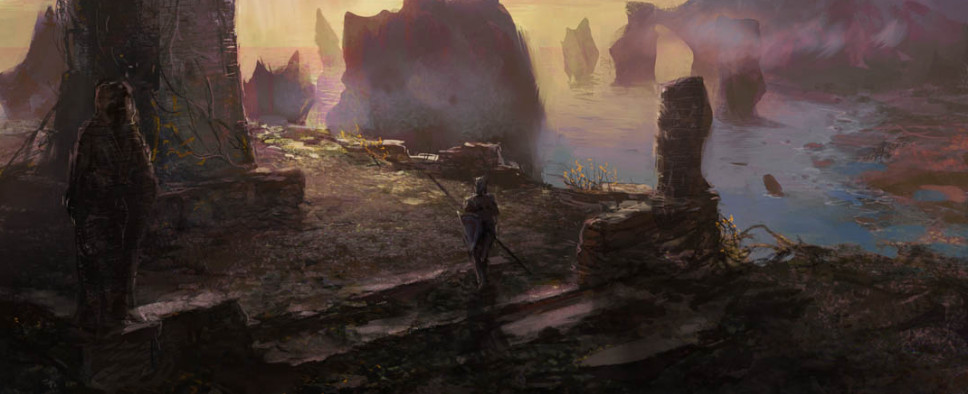Dark Souls II PC Reviews, Interview and Tweak Guide
-
Category: News ArchiveHits: 2011

The release of Dark Souls II's PC port has kickstarter a new round of coverage for From Software's action-RPG, including PC Gamer's own review, which awards the title an enthusiastic 91/100.
Dark Souls was a brilliant game that didn't explain itself well. Many new players were frustrated even by the tutorial because the game didn't teach its secrets to them. Dark Souls 2 fixes that by giving you way more information about its items, skills, and world, liberating its designers to create even more complex challenges. It is more accessible for new players, but not at the expense of being brutal I've died more than 150 times in 60 hours. I curse out loud every time a hollow pushes me off an edge, at every fire arrow I can't dodge, at The Pursuer every god damned time I fight him. I die, over and over, one stupid mistake after another. But even though failing sucks, succeeding in Dark Souls 2 feels absolutely amazing. I'll die a hundred more times just to feel that good when I win.
The publication also offers a tweaking guide penned by DSFix author Peter "Durante" Thorman:
Ambient Occlusion
As you may have noticed in the earlier article, one effect in the game I haven't discussed in depth so far is its integrated ambient occlusion setting. Ambient occlusion is a screen-space post-processing effect which aims to simulate global illumination. The basic idea is that less light reaches places which are behind objects, or inside fissures and gaps, so these locations should be darkened.
The in-game effect is a quite basic implementation, which sometimes gives more of a (2D drop shadow) effect than an approximation of how real light would behave. It's still preferable to not having ambient occlusion at all, but modern methods can do much better. Perhaps the best realtime ambient occlusion method currently available is Nvidia's HBAO+. It can be forced in a variety of games using Inspector, and after a long search I found that the compatibility flag (0x0000001F( works almost perfectly in the game. Sadly, just almost, as the effect gets applied after UI elements have been rendered, so you get strange (shadow) effects on the UI. Nvidia should be able to do something about that with an official profile, but whether they will do so remains to be seen.
Destructoid also has an overall positive PC port report:
Namco released the recommended system specs for Dark Souls II but considering its appearance on the previous generation of consoles, it shouldn't be too much of a burden for an average PC. Whilst the range of graphics options might not be up to the level of a PC-exclusive title, there's room to adjust textures, lighting, anti-aliasing, and both motion and camera blur. My monitor's native resolution of 1920x1080 was supported and the in-game text looked sharp and crisp.
As such, don't be afraid to crank up the graphics settings, despite what the auto-detect option may assign you. Despite having a powerful desktop, I was assigned "medium" for almost all of the graphical settings available. Cranking them up certainly makes a difference as the approach to the coastal hub area of Majula looks stunning.
However, some things can only be improved so much; some character models still look pretty basic despite turning up the graphics settings. It can become really obvious standing next to certain NPCs but on the whole, From Software has done a much better job with Dark Souls II when it comes to graphics.
Meanwhile, Rock, Paper, Shotgun seems to be decidedly cooler on the state of the PC port, and released an interview with Namco Bandai's producer Tak Miyazoe:
RPS: For which specific reasons did you delay the PC version? What specific aspects of the port required more development time? PC ports tend to get delayed frequently, but no one ever really talks about why. Sometimes there are legitimate reasons. Other times it's. questionable.
Miyazoe: We wanted to make sure we provide the most important PC centric features such as improved texture graphics, higher frame rates and also keyboard/mouse mapping controls. We tried to incorporate as much feedback from the PC fans, and spent the extra time in development to deliver the genuine Dark Souls II experience on the PC platform.
RPS: There's a fair amount of multiplayer cheating in Dark Souls' 1'²s PC version. People enabling invulnerability during invasions, etc. While not totally rampant, I'd still say it's been a deal-breaker for many. What, if anything, will you be doing to keep DSII from falling to a similar fate over time? There have at least been bans on the console side, right?
Miyazoe: We have found that it is difficult to eliminate all types of cheating on the PC platform, and ultimately we hope that players pick up the game and play with honor while enjoying the level balancing and designs that we have implemented. We have put in efforts to secure the game as much as possible, but in the end, we depend on the fan loyalty to enjoy the true experience we have designed.
Finally, it's worth noting that the port seems to have shipped with a number of issues. It's difficult to say how widespread they are, and it's possible they might have gotten more press than usual because of the low quality of the previous ports, but it's also exactly because Dark Souls' PC port wasn't very good that I don't feel comfortable wrapping up the article without linking to the Steam official page on the matter (thanks, Computer and Videogames).

